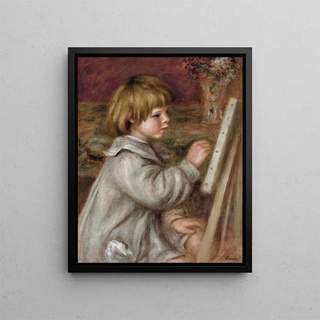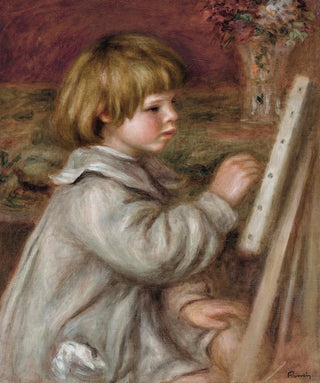Art print | The Little Painter Claude Renoir - Pierre-Auguste Renoir


View from behind

Frame (optional)
Reproduction of Le petit peintre Claude Renoir by Pierre-Auguste Renoir – Captivating introduction
In the fascinating world of Impressionist art, the artwork "Le petit peintre Claude Renoir" by Pierre-Auguste Renoir stands out for its delicacy and tenderness. This painting, depicting his son Claude, captures not only the purity of childhood but also a father's passion for art. The scene, bathed in soft, warm light, evokes a moment of complicity between the painter and his child, thus bearing witness to the intimacy of their relationship. Through this piece, Renoir invites us to contemplate the beginnings of creativity while immersing us in a universe where joie de vivre blends with the beauty of colors.
Style and uniqueness of the work
Renoir's style is immediately recognizable, characterized by fluid, vibrant brushstrokes that breathe palpable life into each canvas. In "Le petit peintre Claude Renoir", the artist uses a palette of gentle colors, dominated by pastel tones that evoke the lightness of childhood. The way he renders the light is particularly remarkable: it seems to dance across Claude's face, illuminating his focused and dreamy expression. The artwork stands out for its serene atmosphere, where every detail—from the child's smile to the blurred background—contributes to visual harmony. Renoir manages to capture the innocence and curiosity of a young budding artist, while celebrating the very essence of the creative act.
The artist and his influence
Pierre-Auguste Renoir, an emblematic figure of Impressionism, left a mark on his era with his unique vision of art. Born in 1841, he was one of the pioneers of this movement that revolutionized painting in the 19th century. Renoir always sought to express the beauty of the world around him, focusing on moments of joy and happiness. His influence is undeniable, not only on his contemporaries but also on future generations of artists. Through his works, he paved the way for a new way of seeing and representing reality, emphasizing the importance of light and color.

Matte finish

View from behind

Frame (optional)
Reproduction of Le petit peintre Claude Renoir by Pierre-Auguste Renoir – Captivating introduction
In the fascinating world of Impressionist art, the artwork "Le petit peintre Claude Renoir" by Pierre-Auguste Renoir stands out for its delicacy and tenderness. This painting, depicting his son Claude, captures not only the purity of childhood but also a father's passion for art. The scene, bathed in soft, warm light, evokes a moment of complicity between the painter and his child, thus bearing witness to the intimacy of their relationship. Through this piece, Renoir invites us to contemplate the beginnings of creativity while immersing us in a universe where joie de vivre blends with the beauty of colors.
Style and uniqueness of the work
Renoir's style is immediately recognizable, characterized by fluid, vibrant brushstrokes that breathe palpable life into each canvas. In "Le petit peintre Claude Renoir", the artist uses a palette of gentle colors, dominated by pastel tones that evoke the lightness of childhood. The way he renders the light is particularly remarkable: it seems to dance across Claude's face, illuminating his focused and dreamy expression. The artwork stands out for its serene atmosphere, where every detail—from the child's smile to the blurred background—contributes to visual harmony. Renoir manages to capture the innocence and curiosity of a young budding artist, while celebrating the very essence of the creative act.
The artist and his influence
Pierre-Auguste Renoir, an emblematic figure of Impressionism, left a mark on his era with his unique vision of art. Born in 1841, he was one of the pioneers of this movement that revolutionized painting in the 19th century. Renoir always sought to express the beauty of the world around him, focusing on moments of joy and happiness. His influence is undeniable, not only on his contemporaries but also on future generations of artists. Through his works, he paved the way for a new way of seeing and representing reality, emphasizing the importance of light and color.






